Auctions
artnet News’ Top 10 Most Expensive Living West Coast Artists
From Ed Ruscha to Robert Irwin, we crunched the auction data.
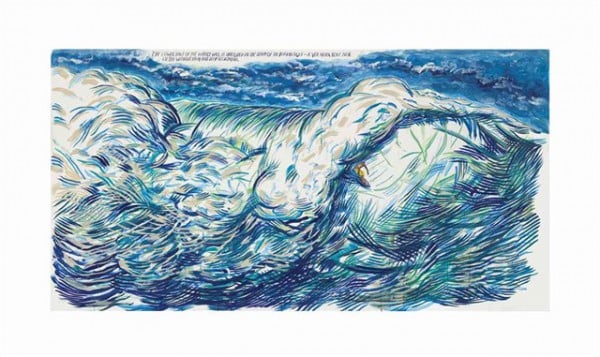
From Ed Ruscha to Robert Irwin, we crunched the auction data.

Rozalia Jovanovic

West Coast artists like to work with the stuff that surrounds them, taking as their inspiration or source material commercial graphics, billboard papers, surf culture, perfect surfaces, gang tagging, or simply the natural light and expanse that are in abundance in the region. These artists also share a cool irreverence and wit that feels somehow borne by the great weather, the lustrous Pacific coast, and the laid-back yet diverse cultures of cities like Los Angeles. Exemplifying these qualities by the carload are the top 10 most expensive living West Coast artists, from big wig Conceptual artists like John Baldessari to younger socially conscious scene-stealers like Mark Bradford.
This list was compiled by a search of the artnet Price Database for the top 300 living American artists, and refined by their current locations (or, as we did in one case, by location for a majority of a career, and because the artist is so indelibly West Coast).
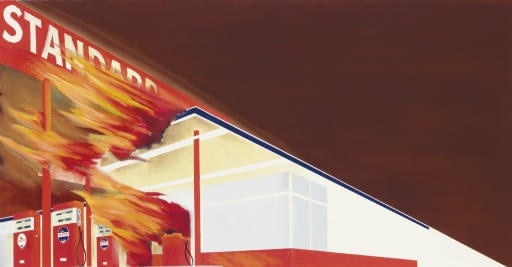
Ed Ruscha, Burning Gas Station (1965–66).
1. Ed Ruscha
Though he might contest it, Conceptual artist Ed Ruscha, who moved to Los Angeles in 1956 to attend the Chouinard Art Institute, is one of the artists most associated with the visual language of the West Coast. Known for his signature use of words and phrases that reference commercial graphics and Pop culture, Ruscha’s paintings, collages, and photographic books are also identifiable by their exploitation of the vernacular of Southern California, from the billboards of the Sunset Strip to the palm trees along Hollywood Boulevard. Burning Gas Station (1965–66), an oil-and-graphite work on canvas which sold in 2007 for $6,985,000 million at Christie’s New York, depicts a gas station with flames shooting out from the roof and gas pumps. It could be anywhere in the US, but it certainly evokes the car culture, natural disasters, and “burning” ambition peculiar to the City of Dreams.
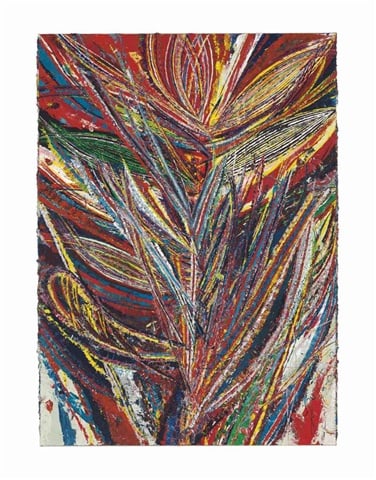
Mark Grotjahn, Untitled (Standard Lotus No. II, Bird of Paradise, Tiger Mouth Face 44.01) (2012).
2. Mark Grotjahn
Mark Grotjahn’s work has its origins in the commercial signage of Los Angeles. In his “Sign Exchange” program, begun while getting his MFA at Berkeley, Grotjahn, who has a studio in LA’s Little Armenia, would paint copies of pictures and words taken from local storefronts (hamburgers, hot dogs, beer, etc.) and then try to exchange his painted replicas for the actual signs (which he’s said had a 90 percent success rate). Even his Butterfly paintings, a series of works in which he employs such perspectival techniques as multiple vanishing points (a Renaissance method for creating the illusion of depth on a two-dimensional surface), feels in dialogue with the sprawl and surface glitter of Los Angeles. The record for his work is held by Untitled (Standard Lotus No. II, Bird of Paradise, Tiger Mouth Face 44.01 (2012), which was sold for $6,510,000 at Leonardo DiCaprio Foundation’s 11th Hour Auction at Christie’s.
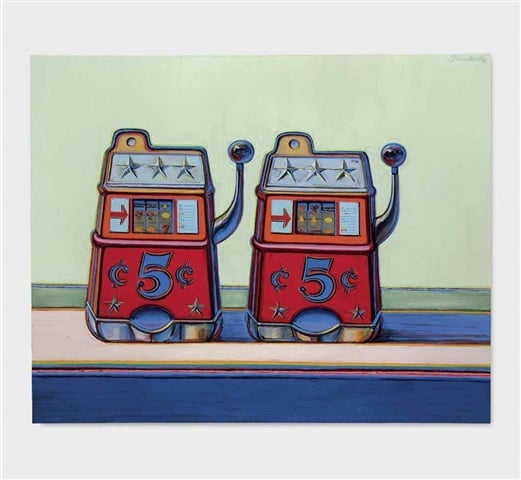
Wayne Thiebaud, Two Jackpots (2005).
3. Wayne Thiebaud
Best known for his brightly colored paintings of ice cream cones, lollipops, and slices of diner cake, Wayne Thiebaud was raised in Long Beach, California, and now lives in Sacramento. He got his start in the animation department at Walt Disney studios in Los Angeles, where as a high school student he made “in-betweeners” of cartoon characters like Goofy and Pinocchio—Mickey Mouse has made its way into the artist’s subsequent creations. Though his early work from the 1950s predates Pop art, Thiebaud became known to the wider public in 1962, when curator Walter Hopps included his paintings in the historic show “New Painting of Common Objects” at the Pasadena Art Museum (now the Norton Simon Museum), the first museum survey of Pop art in America. That exhibit also included the work of Andy Warhol, Roy Lichtenstein, and Ed Ruscha. Today Thiebaud’s realistic depictions of confections and everyday objects continue to interest collectors. Just last year, Two Jackpots (2005), a painting of two casino slot machines, set a new record at auction when it sold at Christie’s for $6,325,000.
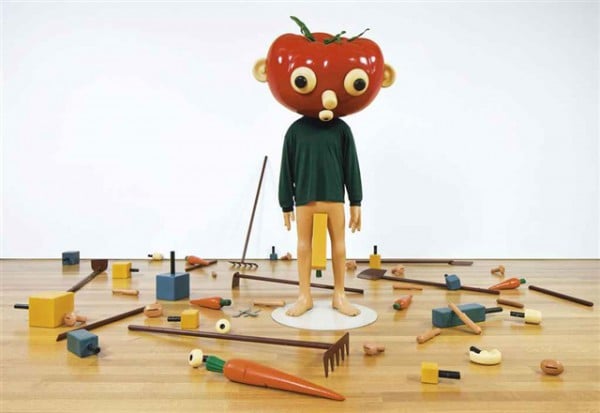
Paul McCarthy, Tomato head (Green) (1994).
4. Paul McCarthy
If Thiebaud is all bright confectionery surface, with occasional earnest odes to Disney, Paul McCarthy upends the Disney fairy tale. For his show “WS” at New York’s Park Avenue Armory in 2013, McCarthy, who lives and works in Los Angeles, continued his well-known concerns with a mixed-media installation that explored the darker imagined side of the characters in Disney’s Snow White and the Seven Dwarfs, with videos showing the characters in a torrid montage of simulated sex acts and a sculptural forest where the videos had been filmed. His record at auction is held by a less outrightly perverted sculpture, Tomato head (Green) (1994), an installation of a pants-less human-like figure wearing a large sculptural tomato for a head surrounded by parts that can be inserted into his body. The work, which evokes the children’s toy Mr. Potato Head with an aberrant twist, sold in 2011 at Christie’s for $4,562,500, more than quadrupling its low $1 million estimate.
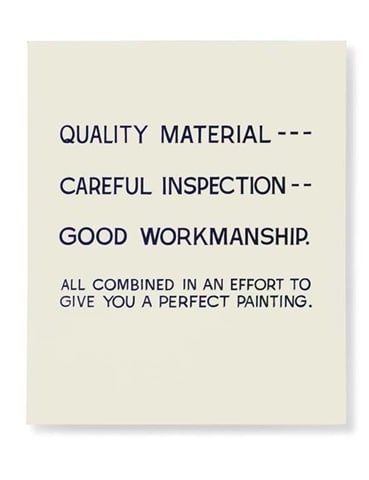
John Baldessari, Quality Material . . . (1967–68).
5. John Baldessari
In 1970 artist John Baldessari destroyed all the paintings he had made from 1953 to 1966. It was an act of disavowal of those earlier works, and he moved on to creating the Conceptual paintings, collages, and sculpture he would become known for. Raised in Southern California, Baldessari is also well known for his “Post-Studio” class at CalArts, where he taught from 1970–1986 (there is a building there named after him). At CalArts he tried to encourage his students (including Mike Kelley and Meg Cranston) to think beyond the traditional mediums of painting and sculpture. His record at auction is held by Quality Material (1967–68), one of his text-based works, which sold in 2007 at Christie’s for $4,408,000, nearly tripling its low estimate of $1.5 million.

Charles Ray, Table (1990).
6. Charles Ray
When looking at a work by LA–based sculptor Charles Ray, you might wonder if what you’re looking at is, in fact, what it appears to be. His subtle plays with scale and perception create gentle tension, such as in works like Family Romance (1993) in which four members of a family—a mother, father, and two young children—are depicted nude, side-by-side, and all of the same height. Ray’s record at auction is held by Table (1990), a steel-and-Plexiglas replica of an otherwise ordinary glass table. It sold for $3,106,500 at Christie’s in 2011.
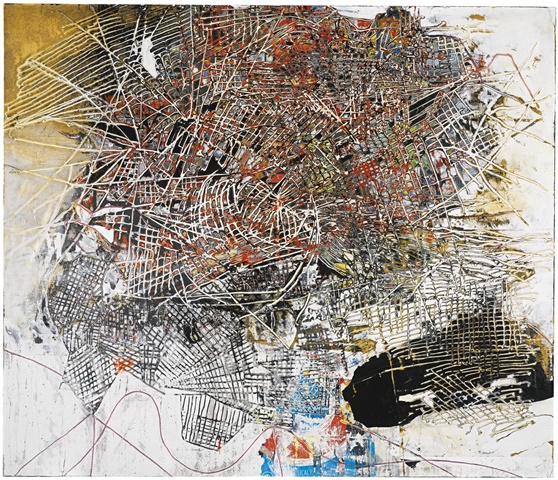
Mark Bradford, Mithra (2008).
7. Mark Bradford
Born and raised in Los Angeles, artist Mark Bradford is known for his exploration of race, gender, sexuality, and class through lattice-like abstract paintings and mixed-media works that incorporate collage created from compact layers of billboard paper, newspapers, and hair perm end papers taken from his mother’s hair salon. For his installation Mithra (2008), inspired by Hurricane Katrina, Bradford built a 64-foot ark of salvaged plywood in the Lower Ninth Ward in New Orleans for an exhibition commemorating the destructive event. His mixed-media collage of the same name, Mithra (2008), which sold at Sotheby’s in 2013 for $2,629,000 (more than four times its low estimate of $600,000), holds the artist’s record at auction. Bradford works in a space he converted from his mother’s beauty parlor in Leimert Park, Los Angeles.

Sterling Ruby, SP231 (2013).
8. Sterling Ruby
Though Los Angeles–based artist Sterling Ruby moved around a lot as a child—he was born on a military base in Bitburg, Germany, then lived in the Netherlands, Baltimore, and York, Pennsylvania. He credits his artistic awakening with the time he found Paul Schimmel’s catalogue Helter Skelter: L.A. Art in the 1990s in the small library at the Pennsylvania School of Art and Design. “It was a red herring—I don’t know how it got there,” Ruby once told artnet in an interview. “I became certain that I was going to wind up in LA, which seemed like it had more pathology than any other city in America.” Ruby frequently references Los Angeles—its gangs and street culture, as well as its West Coast movements like the California craft movement—in works from his spray-painted abstract paintings to his chunky glazed ceramics and poured polyurethane sculpture. His layered and palimpsestic paintings in hot pinks, orange, and acid green that look both like seascapes or walls vandalized by urban markings are the artist’s highest-selling works at auction. SP231 (2013), a work in pink tones, which sold at Christie’s in 2013 for $1,785,000, holds the artist’s record.

Raymond Pettibon, No Title (The Lower Half . . . ), 2013.
9. Raymond Pettibon
A former bass player in the West Coast punk band Black Flag (founded by his brother), with which he was associated in the 1970s and ’80s, Raymond Pettibon’s ink drawings are accompanied by insoucient ambiguous prose, cover subjects as varied as surfing, punk, and even Charles Manson, and have the feel of both hand-made fanzines as well as the woodblock prints by Hokusai. Though he has recently relocated to New York, Pettibon’s spring show at Venus Over Manhattan, which covered three decades of Pettibon’s work depicting California surf culture, demonstrated that taking the West Coast out of the artist isn’t necessarily an option. Pettibon’s No Title (The Lower Half . . . (2013), an acrylic, ink, and pastel work on paper of a surfer catching a giant wave, broke the artist’s record at auction when it sold for $1,575,000 at the 11th Hour Auction at Christie’s. He’s also currently the lead singer in Venice-based band The Niche Makers.
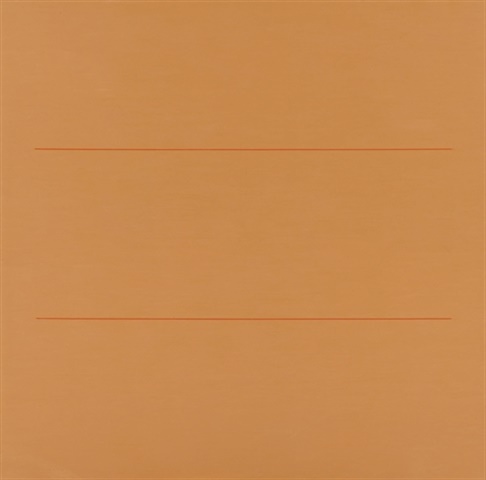
Robert Irwin, Untitled (1963–64).
10. Robert Irwin
A pioneer of the Light and Space movement who was one of the artists that showed with the West Coast’s storied Ferus gallery, Robert Irwin is known primarily for his installation work aimed at altering perception through the manipulation of light and space within the context of the surrounding environment. For a work created in 1980 in Venice, California, he emptied a large rectangular room, painted it white, tinkered with the skylights, and replaced the wall facing the street with a white, partly transparent scrim. When viewed from the street, the ordinary room appeared as a mystical space. Irwin’s career started with painting, however, and it’s these early paintings that seem to be highly prized by collectors. The San Diego–based artist’s record at auction is held by Untitled (1963–64), a minimal painting roughly 84″ × 82″, which sold for $1,058,500, just above its estimate, at Christie’s in 2008.